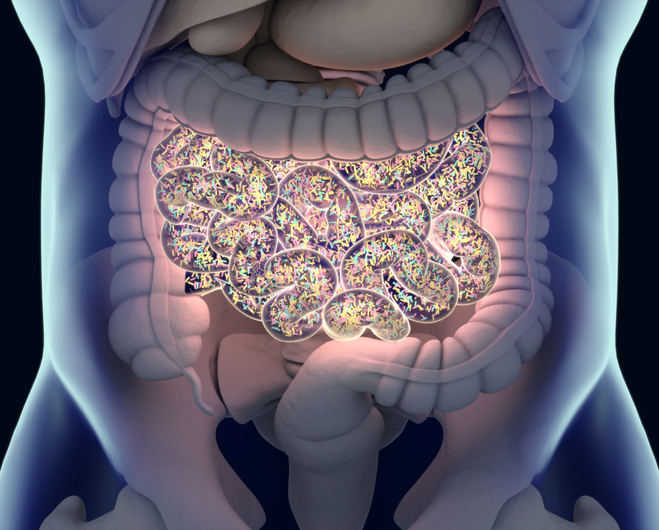
With the human intestinal tract containing the largest concentration of immunological tissue (mucosa-associated lymphoid tissue or MALT), it seems logical that the microbial communities residing within it would impact the surrounding immune cells. But only recently has evidence begun to surface to show the true extent of this microbial influence. As such, investigators at the University of Bern have analyzed the billions of genes that code the antibodies in a system that allows the responses to individual benign intestinal microbes to be understood—finding that the range of available antibodies depends on where beneficial microbes are in the body.
Results from the new study were published recently in Nature through an article entitled “Mucosal or systemic microbiota exposures shape the B cell repertoire.”
B cells develop to produce antibodies and these antibodies, or immunoglobulins can bind to harmful foreign particles (such as viruses or disease-causing bacteria) to stop them from invading and infecting the body’s cells. Each B cell carries an individual B cell receptor (BCR) which determines which particles it can bind, rather like each lock accepts a different key. There are many millions of B cells with different receptors in the body. This immense diversity comes from rearranging the genes that code these receptors, so the receptor is slightly different in every B cell resulting in billions of possibilities of different harmful molecules that could be recognized. Intestinal microbes trigger expansion of these B cell populations and antibody production, but until now it was unknown whether this was a random process, or whether the molecules of the intestinal microbes themselves influence the outcome.
The number of benign microbes living in our intestines is about the same as the number of cells in our body. Mostly these bacteria stay within the intestinal tube rather than penetrate the body tissues. Unfortunately, some penetration is unavoidable, because the intestine only has a single layer of cells that separate the inside of the tube from blood vessels that we need to absorb our food.
In the current study, the researchers used specially designed computer programs to process millions of genetic sequences that compare the antibody repertoire from B cells, depending on whether the microbes stay in the intestine, or whether they reach the bloodstream. In both cases, the antibody repertoire is altered, but in rather different ways depending on how the exposure occurs.
“Here we used a simplified model of defined transient exposures to different microbial taxa in germ-free mice to deconstruct how the microbiota shapes the B cell pool and its functional responsiveness,” the authors wrote. “We followed the development of the immunoglobulin repertoire in B cell populations, as well as single cells by deep sequencing. Microbial exposures at the intestinal mucosa generated oligoclonal responses that differed from those of germ-free mice, and from the diverse repertoire that was generated after intravenous systemic exposure to microbiota. The IgA repertoire—predominantly to cell-surface antigens—did not expand after dose escalation, whereas increased systemic exposure broadened the IgG repertoire to both microbial cytoplasmic and cell-surface antigens. These microbial exposures induced characteristic immunoglobulin heavy-chain repertoires in B cells, mainly at memory and plasma cell stages. Whereas sequential systemic exposure to different microbial taxa diversified the IgG repertoire and facilitated alternative specific responses, sequential mucosal exposure produced limited overlapping repertoires and the attrition of initial IgA binding specificities.”
Co-senior study investigator Stephanie Ganal-Vonarburg, PhD, a senior researcher at the University of Bern added that “interestingly, this is rather predictable depending on the microbe concerned and where it is in the body, indicating that the intestinal microbes direct the development of our antibodies before we get a serious infection and this process is certainly not random.”
There are different sorts of antibodies in the lining of the intestine (IgA) compared with the bloodstream (IgM and IgG). Using the powerful genetic analysis, the researchers showed that the range of different antibodies produced in the intestine was far less than those produced in central body tissues. This means that once microbes get into the body, the immune system has many more possibilities to neutralize and eliminate them, whereas antibodies in the intestine mainly just bind the bacterial molecules that they can see at any one time.
Over their life-span mammals face a huge variety of different microbial challenges. It was therefore important to know how the antibody repertoire could change once it had been shaped by a particular microbe when something else came along. The research team answered this question by testing what happened with the same microbe at different sites or with two different microbes on after another.
Although intestinal microbes do not directly produce an especially wide range of different antibodies, they sensitize the central immune tissues to produce antibodies if the microbe gets into the bloodstream. When a second microbe comes along, the rather limited intestinal antibody response changes to accommodate this microbe (rather like changing the lock in one’s door).
This is different from what happens when microbes get into the bloodstream to reach the central body tissues when a second set of antibodies is made without compromising the first response to the original microbes (like installing another lock, so the door can be opened with different keys). This shows that central body tissues have the capacity to remember a range of different microbial species and to avoid the dangers of sepsis. It also shows that different B cell immune strategies in different body compartments are important for the maintenance of our peaceful existence with our microbial passengers.













